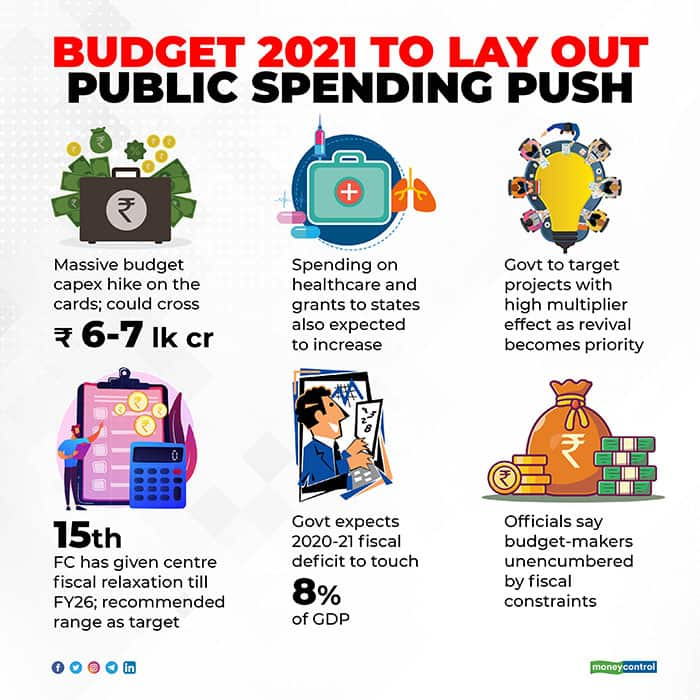



The Narendra Modi government is planning a massive public spending boost in Union Budget 2021-22, which will centre on post-Covid economic revival and employment creation, Moneycontrol has learnt from top government sources.
While the numbers are still some way from being finalised, what is certain is that the upcoming budget will have the highest ever capital expenditure outlay from the central government. A senior official aware of the deliberations in the government said the budgeted capex for FY2021-22 could easily cross Rs 6-7 lakh crore.
For 2020-21, the centre had budgeted its own capital expenditure at Rs 4.13 lakh crore, That has been increased by Rs 35,200 crore, announced by Finance Minister Nirmala Sitharaman in October and November as part of the various Aatmanirbhar Bharat packages.
Also Read: How you can share your ideas for Budget 2021-22 with government
“The focus will be on high-quality spending with a large multiplier effect in terms of demand and job creation. Funding for large infrastructure projects will take centre stage,” said the official.
As Finance Minister Nirmala Sitharaman and her team prepare the budget, the government finds itself unencumbered by strict fiscal considerations. The 15th Finance Commission is learnt to have recommended a fiscal deficit target range for each year of its award period, till 2025-26, instead of a single number.
“The fiscal deficit for this year is expected to be around 7.5-8 per cent of GDP. So that will be our starting point of a fiscal roadmap going ahead. Whatever the centre targets next year will be a gradual reduction from this number,” said a second official.
“The Finance Commission has provided the centre some breathing space till 2025-26,” the person added.
The fiscal deficit target for the current year was budgeted at 3.5 per cent of GDP. That target no longer holds as the Covid-19 pandemic has led to dwindling revenues and higher expenditure commitments for the central government.
Analysts, economists and the private sector are asking the government to ramp up public spending. This, they say will spur demand and lead to revival across sectors.
In normal times, the biggest effect of a burgeoning fiscal deficit is higher borrowing and wider debt-GDP ratio. However, the centre is not concerned on that front for next year. An expected GDP contraction this year, means a low-base effect for next year, which will lead to debt-GDP consolidation.
“Fiscal spending multipliers are higher in a recession period. Next year will see substantial GDP growth because of the low-base effect, and that may reflect somewhat favourably on debt-GDP ratio,” the first person quoted above said.

As reported earlier, the government has identified 50 projects from the National Infrastructure Pipeline into which it aims to pump capital expenditure with an explicit intention of employment generation.
Some of the 50 projects which have been identified include the Jewar International Airport in Greater Noida, Navi Mumbai International Airport, the Chardham Connectivity Highway project, JNPT port Terminal 4, Vadodara-Mumbai Expressway, Ahmedabad Metro Rail and the planned second Chennai Airport.
In a summit organized by news agency Reuters last week, Sitharaman had hinted that the government is planning a public spending boost in the upcoming budget.
Also Read: No pre-Budget meets this year due to COVID
“I have to be conscious that if I don’t spend now, then the stimulus is meaningless; if I don’t spend now the revival is going to get deferred and we can’t afford that,” she had said.
Discover the latest Business News, Sensex, and Nifty updates. Obtain Personal Finance insights, tax queries, and expert opinions on Moneycontrol or download the Moneycontrol App to stay updated!
Find the best of Al News in one place, specially curated for you every weekend.
Stay on top of the latest tech trends and biggest startup news.